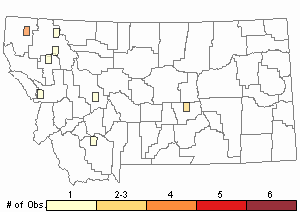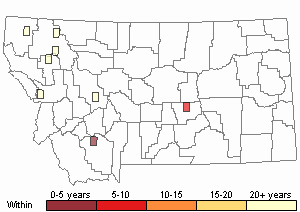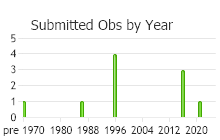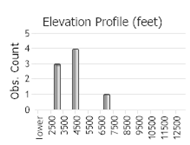View in other NatureServe Network Field Guides
NatureServe
Montana
Utah
Wyoming
Idaho
Wisconsin
British Columbia
South Carolina
Yukon
California
New York
Velvet Moss - Brachytheciastrum velutinum
Other Names:
Bracythecium velutinum
General Description
Plants: Pleurocarpous (Vitt 1988). Growing in open to somewhat crowded upright clumps (FNA 2014) or soft mats (Crum & Anderson et al. 1981), green, yellow-green or brown. Stems prostrate to upwardly inclined, 4-5 cm in length, circular to slightly flattened in X-section, not crowded with appressed, overlapping leaves, branching consistently to erratically pinnate; possessing a central strand. Branches 4-6 mm in length (FNA 2014), occasionally curved (Lawton 1971), circular to slightly flattened in X-section (FNA 2014).
Leaves: Somewhat crowded to distantly arranged, upright or spreading a little, sickle-shaped to coiled, 1-1.8 mm in length, 0.1-0.6 mm in width, lance-shaped, sometimes tending toward ovate, lacking longitudinal folds or with 1 fold near each margin; margins nearly smooth to somewhat coarsely saw-toothed, flat or sometimes curved back and downward below; apex steadily long-acuminate, spreading slightly; costa ca half the leaf length or more, with a terminal spine. Branch leaves smaller and a little more slender (FNA 2014).
Leaf Cells: Alar cells nearly square to short-quadrangular, the alar area small and well-defined; laminal cells long and thin; basal cells quadrangular and short, in 1-2 unclear series (FNA 2014).
Brachythecium velutinum var. velutinum: Present in Montana.
Stems prostrate, consistently pinnate. Stem leaves somewhat crowded to lax, upright and spreading a little, lance-shaped, sometimes with ovate tendencies, 1-1.6 mm in length, 0.1-0.6 mm in width; margins finely saw-toothed at the base, sometimes the teeth coarser above. Branch leaves sickle-shaped, sometimes straight (FNA 2014).
Brachythecium velutinum var. salicinum: Present in Montana.
Stems prostrate to upwardly inclined, erratically pinnate. Stem leaves crowded, upright, lance-shaped, 1.2-1.8 mm in length, 0.3-0.5 mm in width; margins nearly smooth, or finely to more coarsely saw-toothed. Branch leaves not curved (FNA 2014).
Diagnostic Characteristics
The two varieties have a handful of differing gametophytic characteristics. However, these are difficult to distinguish in practice, so that plants in vegetative condition are currently nearly impossible to identify (FNA 2014).
Range Comments
Known in Montana from Fallon, Fergus, Flathead, Gallatin, Glacier, Lake, Lewis and Clark, Madison,
Missoula, and Ravalli Counties (Elliott 2016).
North American Range
Variety velutinum: In Canada, found in YT, BC to NL and NS, and in the USA, MT to NM, w from those to the coastal states, also NE, MN, WI, ME s to NC, TX (FNA 2014).
Variety salicinum: Western states bordered on the east by MT s to NM, TX (FNA 2014).
Observations in Montana Natural Heritage Program Database
Number of Observations: 15
(Click on the following maps and charts to see full sized version)
Map Help and Descriptions
Relative Density

Recency



 (Observations spanning multiple months or years are excluded from time charts)
(Observations spanning multiple months or years are excluded from time charts)
Habitat
Mineral soil, humus, rotting wood, and tree bases from low to high elevations (Elliott 2016).
Variety velutinum: Mineral and organic soil, rotting wood, tree bottoms. Elevation: 0-6890 feet (FNA 2014).
Variety salicinum: Soil and rock, exposed to somewhat canopied habitats. Elevation: 0-9840 feet (FNA 2014).
Reproductive Characteristics
Autoicous (Crum & Anderson et al. 1981). Perichaetial leaves lacking a costa or costa somewhat rudimentary (Lawton 1971). Seta russet, 8-15 mm in length. Capsule level, ca 1.5 mm in length, brown, becoming darker over time (FNA 2014); cilia knobby (Lawton 1971).
Variety velutinum: Seta papillae-roughened from top to bottom (FNA 2014).
Variety salicinum: Seta a little rough below, or entirely smooth (FNA 2014).
References
- Literature Cited AboveLegend:
 View Online Publication
View Online Publication Crum, H.A. and L.E. Anderson. 1981. Mosses of Eastern North America. 2 volumes. Columbia University Press, New York. 1328 pp.
Crum, H.A. and L.E. Anderson. 1981. Mosses of Eastern North America. 2 volumes. Columbia University Press, New York. 1328 pp. Elliott, J.C. and A.K. Pipp. 2018. A Checklist of Montana Mosses (1880-2018). Updated 3 January, 2020. Montana Natural Heritage Program, Helena, Montana. 73 pp.
Elliott, J.C. and A.K. Pipp. 2018. A Checklist of Montana Mosses (1880-2018). Updated 3 January, 2020. Montana Natural Heritage Program, Helena, Montana. 73 pp. Flora of North America Editorial Committee, eds. 2014. Flora of North America North of Mexico. Volume 28. Bryophytes: Mosses, Part 2. Oxford University Press, Inc., NY. xxi + 702 pp.
Flora of North America Editorial Committee, eds. 2014. Flora of North America North of Mexico. Volume 28. Bryophytes: Mosses, Part 2. Oxford University Press, Inc., NY. xxi + 702 pp. Lawton, E. 1971. Moss Flora of the Pacific Northwest. Hattori Botanical Laboratory. Japan: Yamabuki-cho, Shinjuku-ku, Tokyo. 362 pages plus appendices.
Lawton, E. 1971. Moss Flora of the Pacific Northwest. Hattori Botanical Laboratory. Japan: Yamabuki-cho, Shinjuku-ku, Tokyo. 362 pages plus appendices. Vitt, D. J. Marsh, and R. Bovey. 1988. Mosses, Lichens & Ferns of Northwest North America. Seattle, WA: University of Washington Press. 296 p.
Vitt, D. J. Marsh, and R. Bovey. 1988. Mosses, Lichens & Ferns of Northwest North America. Seattle, WA: University of Washington Press. 296 p.
- Additional ReferencesLegend:
 View Online Publication
View Online Publication
Do you know of a citation we're missing? Elliot, J. C. 1993. Second checklist of Montana mosses. Unpublished report. U.S. Forest Service, Region 1. Missoula, MT. 45 pp.
Elliot, J. C. 1993. Second checklist of Montana mosses. Unpublished report. U.S. Forest Service, Region 1. Missoula, MT. 45 pp. Lawton, E. 1971. Keys for the Identification of the Mosses on the Pacific Northwest. Reprinted from 'Moss Flora of the Pacific Northwest'. Published as Supplement No. 2 of the Journal of the Hattori Botanical Laboratory. Nichinan, Miyazaki, Japan. 66 pp.
Lawton, E. 1971. Keys for the Identification of the Mosses on the Pacific Northwest. Reprinted from 'Moss Flora of the Pacific Northwest'. Published as Supplement No. 2 of the Journal of the Hattori Botanical Laboratory. Nichinan, Miyazaki, Japan. 66 pp. Malcolm, B., N. Malcolm, J. Shevock, and D. Norris. 2009. California Mosses. Nelson, New Zealand: Micro-Optics Press. 430 pp.
Malcolm, B., N. Malcolm, J. Shevock, and D. Norris. 2009. California Mosses. Nelson, New Zealand: Micro-Optics Press. 430 pp. Smith, A.J.E. 1980. The Moss Flora of Britain and Ireland. Cambridge University Press, Cambridge. 705 pp.
Smith, A.J.E. 1980. The Moss Flora of Britain and Ireland. Cambridge University Press, Cambridge. 705 pp.
- Web Search Engines for Articles on "Velvet Moss"





